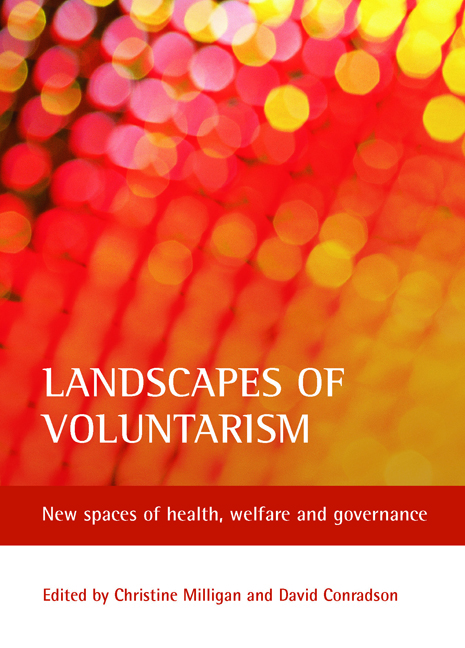Book contents
- Frontmatter
- Contents
- List of tables, figures, maps and plates
- Notes on contributors
- Foreword: Beyond the shadow state?
- one Contemporary landscapes of welfare: the ‘voluntary turn’?
- two A ‘new institutional fix’? The ‘community turn’ and the changing role of the voluntary sector
- three Renewal or relocation? Social welfare, voluntarism and the city
- four Voluntarism and new forms of governance in rural communities
- five New times, new relationships: mental health, primary care and public health in New Zealand
- six Informal and voluntary care in Canada: caught in the Act?
- seven Competition, adaptation and resistance: (re)forming health organisations in New Zealand’s third sector
- eight The difference of voluntarism: the place of voluntary sector care homes for older Jewish people in the United Kingdom
- nine Values, practices and strategic divestment: Christian social service organisations in New Zealand
- ten Faith-based organisations and welfare provision in Northern Ireland and North America: whose agenda?
- eleven Government restructuring and settlement agencies in Vancouver: bringing advocacy back in
- twelve Developing voluntary community spaces and Ethnicity in Sydney, Australia
- thirteen The voluntary spaces of charity shops: workplaces or domestic spaces?
- fourteen The changing landscape of voluntary sector counselling in Scotland
- fifteen Volunteering, geography and welfare: a multilevel investigation of geographical variations in voluntary action
- sixteen Reflections on landscapes of voluntarism
- Index
five - New times, new relationships: mental health, primary care and public health in New Zealand
Published online by Cambridge University Press: 15 January 2022
- Frontmatter
- Contents
- List of tables, figures, maps and plates
- Notes on contributors
- Foreword: Beyond the shadow state?
- one Contemporary landscapes of welfare: the ‘voluntary turn’?
- two A ‘new institutional fix’? The ‘community turn’ and the changing role of the voluntary sector
- three Renewal or relocation? Social welfare, voluntarism and the city
- four Voluntarism and new forms of governance in rural communities
- five New times, new relationships: mental health, primary care and public health in New Zealand
- six Informal and voluntary care in Canada: caught in the Act?
- seven Competition, adaptation and resistance: (re)forming health organisations in New Zealand’s third sector
- eight The difference of voluntarism: the place of voluntary sector care homes for older Jewish people in the United Kingdom
- nine Values, practices and strategic divestment: Christian social service organisations in New Zealand
- ten Faith-based organisations and welfare provision in Northern Ireland and North America: whose agenda?
- eleven Government restructuring and settlement agencies in Vancouver: bringing advocacy back in
- twelve Developing voluntary community spaces and Ethnicity in Sydney, Australia
- thirteen The voluntary spaces of charity shops: workplaces or domestic spaces?
- fourteen The changing landscape of voluntary sector counselling in Scotland
- fifteen Volunteering, geography and welfare: a multilevel investigation of geographical variations in voluntary action
- sixteen Reflections on landscapes of voluntarism
- Index
Summary
Introduction
As in many Western countries, the role of voluntary agencies in healthcare provision in New Zealand has undergone significant change in recent years. At the macro-level, there have been clear shifts in the relationship between the state and the voluntary sector, with tensions evident between central and regional/district levels of decision making as health funding has been devolved but central constraints maintained (Health Services Research Centre, 2003). At a more micro-level there has been discussion of the functioning of voluntary organisations and the nature of volunteering itself, and the way that increased accountability imposed through contracts has required more sophisticated governance arrangements (Nowland-Foreman, 1998). In this chapter we examine these developments in more detail. We begin by providing some historical context and then examine the broad experience of health non-governmental organisations (NGOs) under state restructuring from the mid-1980s to 2005. The term ‘health NGO’ is in current use in New Zealand by government, health funders and voluntary agencies themselves to describe independent, not-for-profit organisations participating in health and disability sector activity. Drawing on the experience of three key health sector groupings – community mental health, primary healthcare and public health agencies – we review how key issues such as contracting and accountability relationships, management and professionalism and good service practice have been addressed since the 1980s. In particular, we show that the introduction of the internal market in the 1990s led not only to the rapid growth of health NGOs, but also to the emergence of substantial regional differences in contracting relationships and public accountability. At the same time, however, the new decentralised contracting environment, while encouraging innovation, undermined good service practice by making it more difficult for health NGOs to cooperate with each other and represent their communities effectively. The chapter has a particular focus on the period since the late 1990s when a more constructive relationship between health NGOs and the state began to evolve. Given the concentration of much research on larger voluntary organisations (Halfpenny and Reid, 2002), and the need for place- and sector-based interpretations of voluntarism (Fyfe and Milligan, 2003a, 2003b; Milligan and Fyfe, 2004), we conclude with a discussion of the implications of this experience at both macro- (governance and accountability) and micro- (NGO process and practice) levels.
Historical context
In the early days of organised government in New Zealand, the state resisted strongly any involvement in health and welfare provision, believing that this responsibility was better discharged by family and community assistance as the need arose (Thomson, 1998). Voluntarism in health services, therefore, has a long history. In the mid-19th century hospitals were established in the new colony by local subscription, with the state having minimal involvement, although from the late 19th century local authorities had a role in supporting both hospitals and charitable aid (Tennant, 1989).
- Type
- Chapter
- Information
- Landscapes of VoluntarismNew Spaces of Health, Welfare and Governance, pp. 73 - 90Publisher: Bristol University PressPrint publication year: 2006



